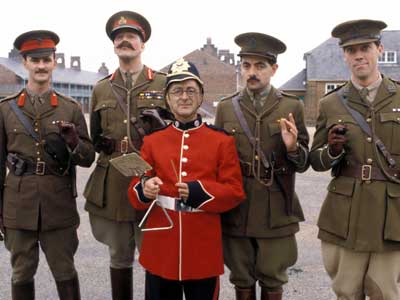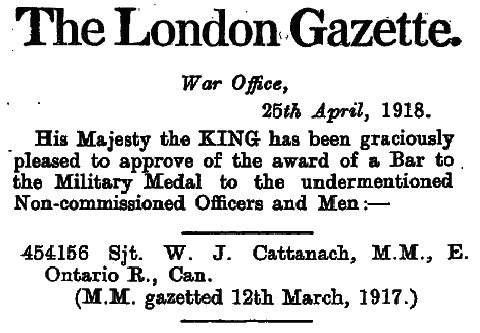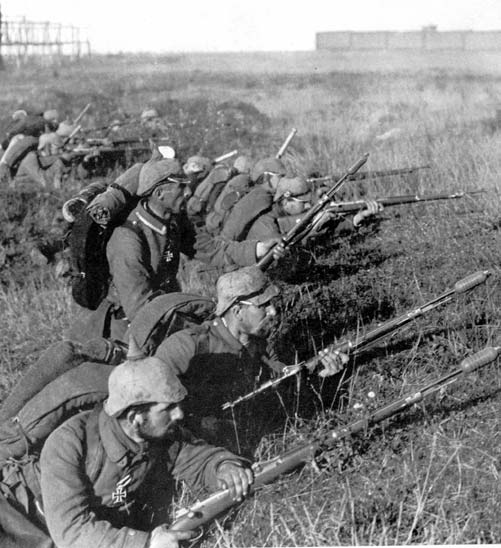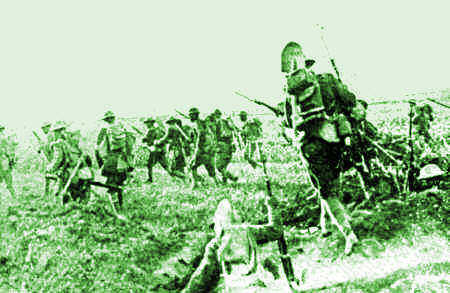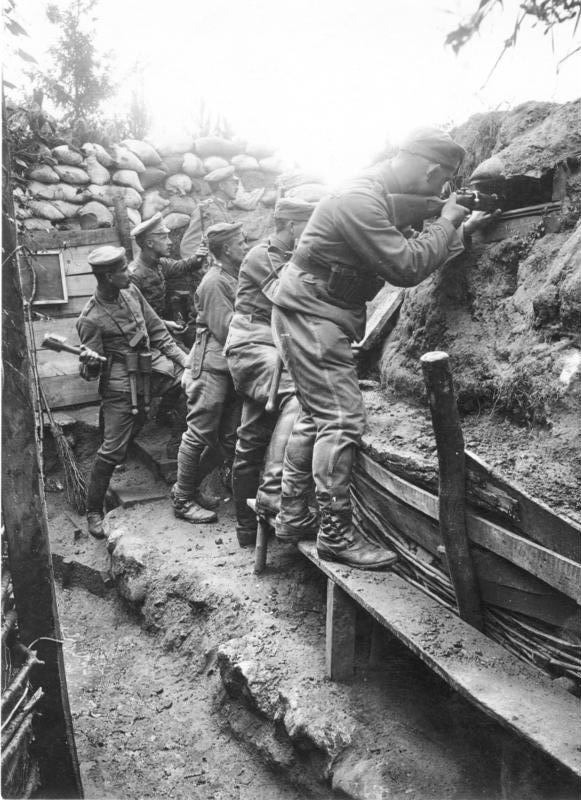There are ten letters: four from 1917, six from 1918, and one written after his return to the United States in 1919. I am dismayed to say that someone has disposed of most of the covers; I have only four, and it is guesswork assigning which goes to which letter. I should, I suppose, have begun with the first in chronological order, but this one was the first that I opened when I found the package, and it starts during an artillery bombardment, just after his position has been bombed by German aircraft, so it seemed the exciting in medias res to start off with.
I've added a few comments after the letter.
*****************************************************************************
[superscript
at 90* in the upper corner, presumably as a postscript]
It is
splendid about your new gloves! Bravo!!
Hqrs.
56th Inf. Brig.
A.P.O.
744
October
23, 1918
My
dearest Dolly
A
Boche has just been overhead dropping bombs on us, so I begin to
understand your feelings when they did it to you in London. They are
rather dirty beasts, aren't they, although when they brought a
prisoner in the other night I didn't feel much but pity for him. He
was an Alsatian, the son of a French soldier, with three sisters &
a girl in Paris. He was helpless and pathetic & it made me more
disgusted than ever with the system that dragged him into this
heartless, senseless business. It has seemed more unreal & more
amazing since I have been here than it ever did before, & at this
moment, when the roar of an artillery operation is going on, I can't
realize [?] that it is grown men trying to smash other grown men in
the lovely golden woods I looked at today. It is too bad that the
spirit has to be born again in just this way. If all this labor had
been put into something permanent & constructive, what a
wonderful place the world would be to live in?
Just
at that moment, they came in with a nice letter from you enclosing a
very interesting one from Bob. He writes splendid letters, doesn't
he? Well, there are two Paradises now in the arena & one just
outside it. I wish he could get an assignment to a regiment, because
you really do feel better in this part of the world even though it is
very much dirtier & rather more dangerous. I shall send you back
Bob's letter, because I have no way of keeping it in this land where
you travel with a tooth-brush, & quite soon lose that. It seems
incredible that people have houses and can have more than three pairs
of shoes & two suits at one time if they want to! I left
practically everything I own at La Brosse, which is an exceedingly
nice place. Did I tell you that I saw my nice Countess in Paris for a
few minutes & had a sad parting with her? We are really very good
friends, & I like her a lot. She paid me the great compliment of
saying that I was "délicat" & gave me an awfully nice
cigarette holder. It was great luck from a selfish point of view, to
fall in with the de la Chapelles, because we really saw something of
France, & have an open house here whenever we want it. I don't
suppose I can ask for leave for some time, now, because they will
probably put this division into a more active sector before long.
I
am too sleepy to know what I want to say & I think that I shall
go to bed, & go on tomorrow. We shall probably get retaliation
for this artillery fire pretty soon & I had better get my sleep
now. Good night, my dear.
The
next morning
They
bombed us & shelled us & shot machinegun bullets at us &
brought in German prisoners all night, but none of it was near enough
to make us get up and hunt cover. But it was rather irritating
because it wasn't very easy to sleep with our heads ready to drop at
any moment. The French on the left picked one of them up with a
searchlight & shot shrapnel at him, & it was a very pretty
sight.
I
shall appreciate the home in America after all this, although I must
say the I rather enjoy this stuff. But I am nothing but a civilian in
khakhi [sic] -- and I shan't be sorry to be in mufti again. It was a
great thing to be born just when I was. Five years later & I
should have left lost the greatest experience of
generations, & the greatest opportunity. Life here is simple &
uninvolved with nothing but Germans & things to worry about,
nevertheless, and has distinct advantages.
I
had a letter from Wayland in the same mail that brought your. He has
been over here for some time -- having flown across the Channel in an
aeroplane with some other people. Lately he has been in a hospital in
Tours with the Spanish flu, which is one reason you haven't seen him.
He liked you all very much, indeed.
Au
revoir, donc, ma chérie. J'étais enchanté d'avais recu ta lettre,
comme toujours, parceque elle me faisait comprendre un peu de la vie
que j'aime si passionement. Toutes mes remerciements.
Mille
tendresses,
Burton
OK
N.B.
Paradise
2nd
Lt., Inf., A.D.C.
[Translation
of last paragraph: Goodbye, then, my
dear. I was delighted to have received your letter, as always,
because it made me understand a little of the life that I love so
passionately. All my thanks.
A thousand tendernesses, ]
A thousand tendernesses, ]
*****************************************************************************
I have to thank my grandfather, Burton (who, to my sorrow, died in 1942, before I ever had a chance to know him) for his excellent handwriting. It's generally very clear, and the few words that are sometimes tricky I can usually deduce from context.
Factoids: I'm hoping to learn more about the de la Chapelles, of whom I assume his comtesse is one. I'm hoping they are related to le Comte Jean Joseph Xavier Alfred de la Chapelle, who was a bit of a daring adventurer in the 19th century: California Gold Rush man, travelled to Australia, then to Morocco during the French conquest, then participated in and wrote a history of the war of 1870. I don't know whether La Brosse is their home; I'm assuming it is, but both la brosse (the brush) and la chapelle (the chapel) are such common words that it will take much more than Google work to find more information. (Though Google did help me find this entry in the Oxford Dictionary of National Biography: La Chapelle, Victor Octave Xavier Alfred de Morton de, Count de La Chapelle in the French nobility (1863–1931), lawyer and wildfowler, possibly this friend of Burton's.)
I'm pretty sure that the comtesse is the same person who, according to a family story, entertained Burton and his brother Bob (a decorated flyer) at a hunting lodge after to war and, when they sighted a handsome stag as they were out shooting one day said, "Oh, but that is Teodor! We NEVER shoot Teodor!"
I'm not sure who Wayland was, other than to presume he's a family friend (it's not a family name that I recognize).
I'm interested to see if NBP's attitude towards the war remains the same. I came across some stuff he wrote while he was in training back in the States, and it's pretty Boys Own Paper bumpf about freedom and humanity and fighting the beastly Hun. I don't know if this rather starry-eyed view of the war survived whatever front line experiences he had.
Edited to add: I'm pretty sure, by the way, that the last text block, which is written in the bottom left corner of the last page, is the "passed by censor" mark. Which suggests that he was taking advantage of his position as an aide de camp to the division commander to "censor" his own letters. Tricky bugger. :-)
.JPG)


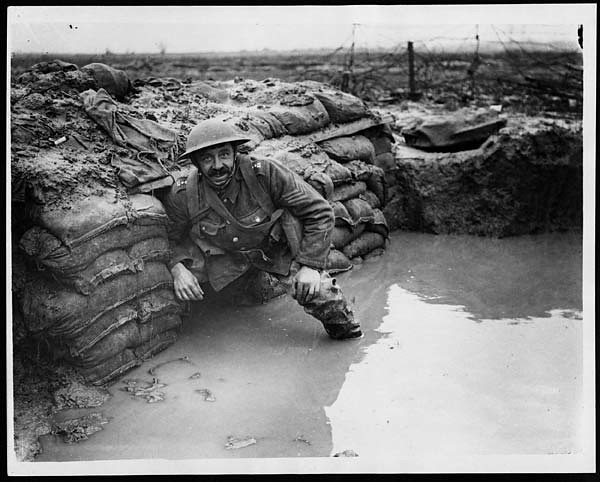


.jpg/400px-German_Barrage_Fire_at_Night_(Ypres).jpg)
